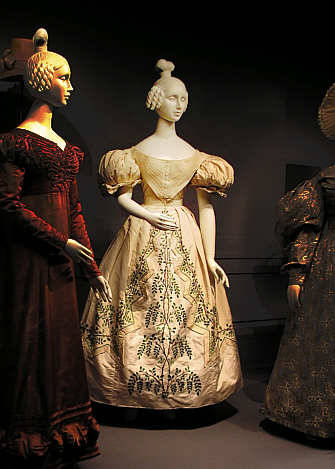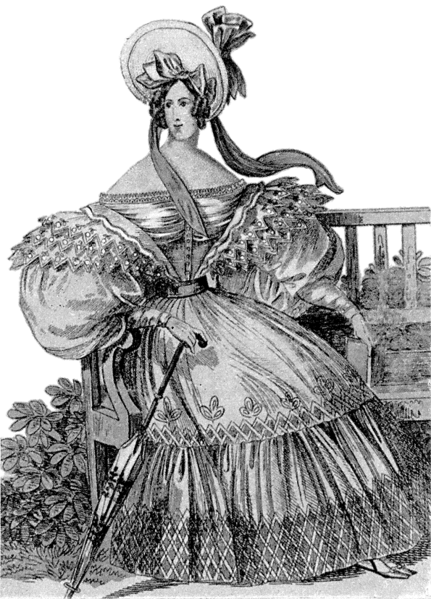Happy 4th of July! I hope you're enjoying your day. To add to the fun and festivities, I've got a gem of a decade this week: The 1830's!
In the 1830's, everything got
bigger. For instance, the US national debt and unemployment rates, under new president Andrew Jackson during the
Panic of 1837 (after the former was briefly paid off for the only time in US history). Skirts, sleeves, shoulders, bonnets, and almost every other element of the female wardrobe also enlarged (accounting for my nerd humor in the post title. Sorry, guys, I couldn't resist).
Outside of America, a monumental change took place in the latter part of the decade, the ascension of Queen Victoria to the throne of Great Britain. You heard that right, we're now officially in the Victorian Era.
 |
| Source. Anyone else reminded of Molly's tartan dress in "Wives and Daughters"? |
Bold patterns, giant sleeves, and full skirts were the norm at the beginning of the decade. That will stay basically the same for the entirety of the 1830's, although the change in sleeves is an interesting thing to watch. Though the sleeves stay freakishly large, the position changes as the decade wears on.
The way I see it, there are four types of sleeves that are common in the decade. First, we have the giant puffs that begin at the shoulder (or a smidge below) and end just below the elbow, with tighter sleeves down to the wrist. Seen above and below.
Next, there are the random bursts of volume near the elbow, flanked by tighter sleeves on the upper and lower arm.
Third, we have the narrower sleeves that tend to be a little fuller towards the bottom.
There were a few exceptions, but on the whole, the first style of sleeves was worn during the beginning of the decade, the second in the middle, and the third near the end. Just in case you want to do any historical fashion sleuthing.
Last but not least, we have the short, puffy sleeves popular during the entire decade for evening wear.
Now, I know I made a promise not to blog about undergarments, but I feel like I need to show you the "sleeve plumpers" that made these sleeves work.
Sleeves weren't the only thing that got bigger during the 1830's; the amount of accessories and decoration skyrocketed, creating the image most fashion scholars have of a laughable decade full of ill-advised sartorial choices.
Here's one webcomic author's humorous point of view on the decade, and why they chose not to make the costumes in the comic
too accurate (also, take a minute to look around the comic. Ada Lovelace and Charles Babbage fight crime in a steampunk alternate universe? Intriguing).
Back to ridiculousness.
As seen above, hair styles and accessories went crazy. The taller, the better, and the sheer amount of stuff worn in women's hair is staggering. It's often a subject of animated conversation when we watch "Wives and Daughters." Because honestly.
So, with all of this craziness going on, I have one question. How is it that Sandy Powell, costume designer for "The Young Victoria" managed to make the 1830's look so incredibly beautiful? To see what I'm talking about, check out
The Young Victoria page on costumersguide.com.
The costumes from "The Young Victoria" make me think that underneath all of the wacky, crazy antics those 1830's ladies were up to, there was a real elegance, and a propensity among women to be unabashedly girly. Sure, it looked pretty silly, but it's also really fun. See you next week.














No comments:
Post a Comment
,mmmmmmmmmmmmmmmmmmmmmmmmmmmmmmmmmmmmmmmmmmmmmmmmmmmmmmmmmmmmmmmmmmmmmmmmmmmmmmmmmmmmmmmmmmmmmmmmmmmmmmmmmmmmmmmmmmmmmmmm'aaaaaaaaaaaakAAAQA
I was going to type something clever, but my cat provided this triumph of literature. Thank you for commenting! Just keep it clean, on-topic, and respectful.